German Russians of Ellis County, Oklahoma Territory
25
The Oklahoma Historical Society notes that over the period of years from 1889 to 1910 eight major clusters of Germans from Russia emerged in western Oklahoma. A significant characteristic of the German-Russian settlement pattern was their tendency to form a dispersed rural community often lying along a river and its tributaries. Another hallmark was their focused community life, centered around a church or a small town. In particular, between 1900 and 1902 Volga German-Russians moved from Marion, Kansas, to Shattuck, Oklahoma. This colony proved to be the state’s most cohesive and long-lasting[1].
The Center for Volga German Studies[2] notes that the Volga German-Russian congregations in the Shattuck, Oklahoma area are:
- Christ Lutheran Church (Formerly known as St. Paul Lutheran Church)
- Ebenezer Baptist Church (Formerly known as First German Baptist)
- Seventh Day Adventist Church
The following 1936 Oklahoma Counties General Highway Map shows the relative locations of Goodwin, the St. Paul Lutheran Church and Cemetery, the First German Baptist and Cemetery, and the Seventh Day Adventist Church and Cemetery to the Kirmse and Lohmann homesteads.
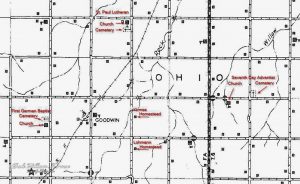
This chapter describes these three churches and cemeteries south of Shattuck, Oklahoma that were originally around Goodwill, Oklahoma.
St. Paul Lutheran
Church History
St. Paul Lutheran Church was founded on 5 March 1905 under the leadership of Pastor Henry Asmus Marxen of Enid, Oklahoma. His brother, James Nicolaus Marxen, came to serve the congregation later that year. The cornerstone for the original church building was laid on 9 October 1905 southwest of Shattuck. It was dedicated on 11 March 1906. The church location was across the road west of the cemetery. This church was built in the style of the German Russian traditions.
![St. Paul Lutheran Church near Goodwin, Oklahoma. [2]](https://pressbooks.pub/app/uploads/sites/4089/2018/08/shattuck_christ_lutheran1_300-1-300x174.jpg)
Today, there is no Lutheran church building near Goodwin.(See Chapter: Goodwin Lutheran Church and Cemetery – 2015)
From 1905 until 1943, the congregation was served by pastors from the Iowa Synod. Since the arrival of Pastor Waldo Bentrup in 1948, the congregation has been a member of the Lutheran Church – Missouri Synod. A new church building was constructed in Shattuck. In 1965, a dual parish was formed with Zion Lutheran Church in Follett, Texas, but that congregation has since closed. From 1978-1985, Christ Lutheran Church was part of a dual parish with Trinity Lutheran in Woodward. A new church was built across the street from the old one in Shattuck, and on 20 June 1982 it was dedicated. A bell tower was added in 1994.[3]
Cemetery
The St. Paul Lutheran Cemetery is one of distinction. It is the only cemetery in Ellis County, Oklahoma that is not platted squarely. This is shown in the following Google Earth map image.
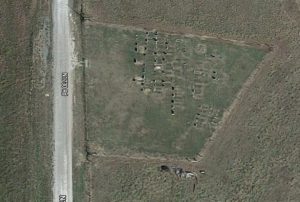
Also, it is the only Ellis County cemetery with several metal cross markers used instead of the traditional headstones. These metal cross markers are a very common sight in many Kansas cemeteries. Especially those of the Volga German-Russian Emigrant settlements.
Location: 3 miles south, 2 miles west and 1/4 south of Shattuck on the east side of road. (NW Quarter of SEC-7 TWN-20N R-25W) Ellis County, Oklahoma.
Sources
- Christ Lutheran Church: 100th Anniversary Celebration, 2005. http://cvgs.cu-portland.edu/immigration/united_states/oklahoma/shattuck/shattuck_st_paul_lutheran.cfm
- Find A Grave – Lutheran Cemetery (Also known as: Saint Paul’s Lutheran Cemetery) https://www.findagrave.com/cemetery/98158
- The Oklahoma Cemeteries Website – St. Paul Lutheran Cemetery (Also known as Christ Lutheran or Lutheran) http://www.okcemeteries.net/ellis/lutheran/lutheran.htm
First German Baptist
Church History
The First German Baptist Church of Woodward County, Oklahoma was officially organized on April 24, 1904. After meeting in a couple of area schools, a small church building was built, A new name, The German Baptist Church, Goodwin, Oklahoma was chosen when Ellis County was formed. This group was led by John George Ehrlich. In 1946 the name was changed to Ebenezer Baptist Church of Shattuck, Oklahoma. A new church was built in Shattuck and dedicated in 1950.
Cemetery
The church and cemetery were located in the SE quarter of land owned by Friedrick Herber. The cemetery was established first, since church meetings were held in homes and schools prior to the 1904 date.
Near the fence in the NE corner of the cemetery is buried an unknown Longhofer. Mr. John Longhofer owned the NE 1/2 Section bordering the cemetery, but at this time a relationship is unconfirmed. Reportedly there were more graves outside the west fence line. Supposedly one to three Mexican railroad workers were buried on the west side of the cemetery. The fence was moved to the east several years ago.
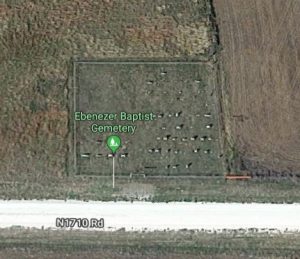
Location: 5 miles south, 4 miles west and 1/2 mile south of Shattuck, (SE Quarter of SEC-22 TWP-20N R-26W) Ellis County, Oklahoma
Sources
- The Oklahoma Cemeteries Website – Ebenezer Baptist Cemetery (Also known as German Baptist): http://www.okcemeteries.net/ellis/ebenezer/ebenezer.htm
- Find A Grave – Ebenezer Baptist Cemetery https://www.findagrave.com/cemetery/2374264/ebenezer-baptist-cemetery
Seventh Day Adventist
Church History
The Shattuck Seventh Day Adventist Church was organized in the winter of 1901-1902 by the local German settlers in the community under the guidance Jacob Lorenz and G.F. Haffner, who was the director of all the German work in North America. He and his wife decided to make their home in this area.
Services were first held in the Kahoe School, 3 miles south and 1/2 mile west of Shattuck. The church was planned in 1903. The church land, located 5 miles South and 1/2 E. of Shattuck was donated by Henry Schultz (See Comment E below). A new church building was constructed in Shattuck.
Cemetery
The land for the cemetery 1/2 mile east of the church was donated by David Oblander. On several of the 1920’S Death Records, the cemetery was listed as the “Weiss Cemetery” as well as Seventh Day Adventist Cemetery.
In keeping with the old world traditions, the burials in the beginning were in order of death, also, the graves were often “stacked”, with up to three in a space. In current times, family headstones and places are reserved, but for the most part the graves are still placed in order of death.
The first person buried in the Seventh Day Adventist Cemetery was an American woman of Non-German descent who was traveling through the community when she died, no one knew her name. The date of death was not recorded. The first Seventh Day Adventist burial was in 1907.
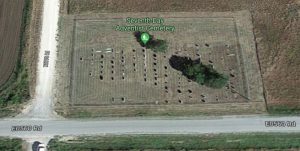
Location: 5 miles south and 1/2 mile east of Shattuck (SW Quarter of SEC-15 TWP-20N R-25W); Ellis County, Oklahoma
Sources
- History of the Oklahoma Conference. http://www.oklahomaadventist.org/article/21/about-us/history-of-oklahoma-conference
- The Oklahoma Cemeteries Website – Seventh Day Adventist Cemetery (Also known as: Adventist or Weis or Weiss Cemetery) : http://www.okcemeteries.net/ellis/adventist/adventist.htm
- Find A Grave – Seventh Day Adventist Cemetery: https://www.findagrave.com/cemetery/2189728
Social Culture
According to Timothy Egan in his book, ‘The WORST HARD TIME’, church was the one place where a person named Schoenhals or Hofferber did not have to pretend to be somebody else. In church the German-Russians sang “Gott is de liebe” and made such a month-long fuss over Christmas that customs in America changed as well. They were a culture frozen in place in 1763 and transplanted whole to the Great Plains.[4]
Timothy Egan notes that at a wedding in 1929, “women served a dish of cabbage that had been shredded by wooden kraut cutters, mixed with ground pork and onion, wrapped in bread dough, and baked. Another table was laden with Kase noodle, made with thick cottage cheese and onion tops. Butterball soup was steaming and rich. A pig’s skull had been rendered, boiled again, and transformed into hog’s head cheese. Chickens were roasted; tubers peeled, boiled, crowded into tanks of potato salad. The women milled their own grain and from that, using eggs from their henhouses and milk from their barns, baked dozens of cakes and pies. They brought stewed apples and pickled watermelons as well. Men did not cook. Men made beer — strong, thick, yeasty. Men made wine, using grapes that arrived by train from California or were grown on arbors on a protected side of a barn. Men killed pigs and made sausage, the organs chopped with salt, pepper, and garlic, stuffed into casings of large intestines and smoked.”
“For five days in advance, the women of Shattuck, Oklahoma, had been cooking for this wedding, and the scent of fresh-made wurst and strudel drifted out the church to the fields. In the German settlements on the High Plains, there was no more defiant celebration of group survival than a wedding. The rest of the year, the Anglos could make fun of their clothes, the sheriff could call them in for questioning, the merchants could refuse them entry into stores, the children could mock their accents, the farmers could laugh at their planting methods, and other immigrants could deride them as “Rooshians.”
But the wedding day on this Sunday in September 1929 belonged to the Germans from Russia. Through an improbable journey of 166 years, they had bounced from southern Germany to the Volga River region of Russia to the Cherokee Outlet of Oklahoma. The Russlanddeutschen were not Russian nor were they fully German. Hardened by long exile, state cruelty, and official ridicule, they wanted only to be left alone. The treeless expanse of the southern plains was one of the few places in the United States that looked like home.”[4]
Comments
- In addition to Anglo-American homesteaders during and after the 1893 opening, Germans from Russia (German in ethnicity but Russian by birth) settled in the Shattuck/Goodwin area in 1901 and 1902. They had previously lived in Marion County, Kansas. In Ellis County, Oklahoma, these Germans from Russia formed an ethnic island around Shattuck, and they made their living by wheat farming. Their settlement was homogeneous, in that most of them had come from four towns in the Volga River valley.[5]
- According to The Center for Volga German Studies at Concordia University[2], the following Volga German-Russian families are known to have lived in and around Shattuck: Appel, Batt, Becker, Bender, Blehm, Borth, Busch, Diel/Deal, Ehrlich, Feil/Fiel, Fritzler, Gantz, Grasmick, Haffner, Hanschu, Heffle, Helzer, Herber, Kelln, Kerbs, Klein, Koch, Laubhan, Link, Longhofer, Meier, Oblander, Renner, Rexius, Riffel, Ruf, Schick, Schoenhal, Schultz, Sell, Shibelhute (Scheibelhut), Siebenlist, Spomer, Steinert, Steinle, Treiber, Winter/Winters, Wunsch, Youck (Jauk). The surnames of the burials in the above cemeteries mostly have these family names.
- The Oklahoma Cemeteries Website – St. Paul Lutheran Cemetery states that “In 1906 Mr. Michael Borth helped build the St. Paul’s Lutheran Church on the David Sell Homestead.’ This is not correct. David Sell’s homestead[6] was the (SW Quarter of SEC-23 TWP-20 R-26) which adjoins the Ebenezer Baptist Cemetery located on the (SE Quarter of SEC-22 TWP-20 R-26)
- The 1936 Oklahoma Counties General Highway Map is in error on the location of the St. Paul Lutheran Cemetery – the cemetery should be on the east side of the road.
- The 1936 Oklahoma Counties General Highway Map shows a school where the Seventh Day Adventist Church was located. However, the following 1910 Landowner map shows the Seventh Day Adventist Church on the land of Conrad C. Weiss who bought the land from Henry Schultz.
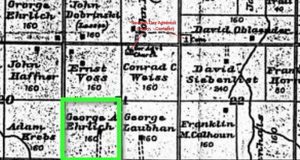
Seventh-Day Adventist Church and Cemetery. The homestead of George Alexander Ehrlich is bordered in green. - The “Pioneer History of Shattuck” book, which is a locally compiled history of the early settlers in Shattuck and surrounding area, shows the following picture as being the Lutheran Church in Goodwin, Oklahoma.
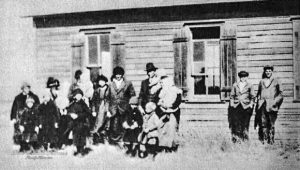
Lutheran Church Goodwin – NOT This picture does not match the picture of the St. Paul Lutheran Church built in the style of the German Russian traditions – note no arched windows. I suspect that this picture is mislabeled and is of the small German Baptist Church (later known as Ebenezer Baptist Church) of Goodwin.
Discussion
It was into this Volga German-Russian colony that my grandparents, William and Martha Kirmse, homesteaded. They joined the Lutheran Church that was located two miles from the Kirmse farm.[9] According to my father, Julius Kirmse, who was born in a sod house near Goodwin, that while their neighbors and the members at church were friendly, the Kirmse family was socially isolated. As noted above, the German-Russians were close knit families.
Notes
- Dianna Everett. GERMANS FROM RUSSIA. Oklahoma Historical Society. Downladed from: http://www.okhistory.org/publications/enc/entry.php?entry=GE008 October 26, 2017.
- The Center for Volga German Studies Shattuck, Ellis Co., Oklahoma Downloaded from http://cvgs.cu-portland.edu/immigration/united_states/oklahoma/shattuck.cfm
- The Center for Volga German Studies “Christ Lutheran Church Shattuck, Oklahoma” Downloaded from http://cvgs.cu-portland.edu/immigration/united_states/oklahoma/shattuck/shattuck_christ_lutheran.cfm October 24, 2017.
- Timothy Egan, ‘The WORST HARD TIME’. Houghton Mifflin Harcourt Publishing Company, New York, New York. 2006. Chapter 4 High Plans Deutsch, page 68.
- Dianna Everett. Shattuck. Oklahoma Historical Society. http://www.okhistory.org/publications/enc/entry.php?entry=SH010
- David Sell Land Patent, Bureau of Land Management https://glorecords.blm.gov/details/patent/default.aspx?accession=OK1810__.392&docClass=STA&sid=pazbxebl.sln#patentDetailsTabIndex=1
